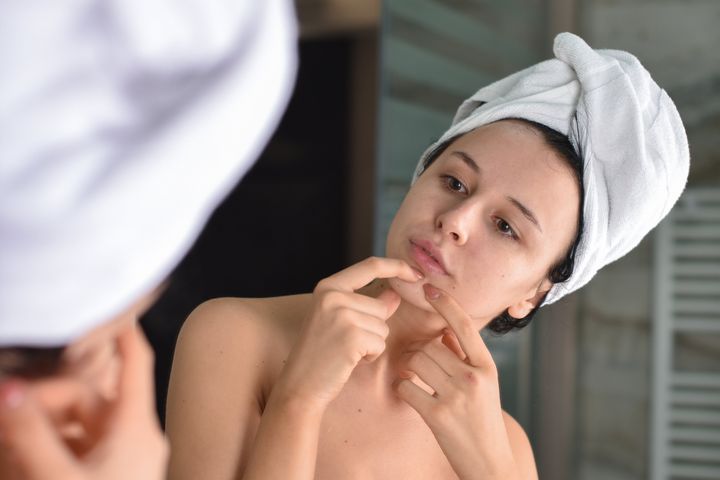Strangely long chin hairs: They’re not a facial feature most women welcome, but they’re a reality for many people, especially as they age. In fact, in a memorable and relatable TV moment, talk show host Rosie O’Donnell once showed off a chin hair so long she was able to put a little bead on it.
O’Donnell’s candor is to be respected, but when those random chin hairs sprout seemingly out of nowhere, it’s normal to wonder why it’s happening in the first place ― and what you can do about them. We asked an endocrinologist and a dermatologist to share everything you need to know.
Blame it on your hormones
Dr. Ana Kausel, an endocrinologist at Mount Sinai Health System in New York City, said that when women grow hair in a pattern and thickness similar to that of men, it’s called hirsutism. As we age and enter menopause, our hormones begin to shift, and when that happens, hairs may sprout where there weren’t any before.
“All women have both estrogen and testosterone, but in our reproductive years we tend to have more estrogen than testosterone and this balances the testosterone’s side effects,” Kausel said. “As we age, there’s a higher imbalance, since estrogen disappears but the production of testosterone remains, making androgens more potent and leading to side effects like chin hair.”
As board-certified cosmetic dermatologist Dr. Michele Green explained it, androgens — a group of hormones that include testosterone — interact with hair follicles and activate them to produce terminal hair, or hair that is longer, thicker and more deeply rooted, like beard hair. As a woman’s body produces less estrogen and testosterone becomes dominant, facial hair is more likely to sprout.
Of course, this doesn’t happen to everyone. And whether you do or don’t get those long chin hairs comes down to your genetics.
“Hair follicles are unique, and their sensitivity to androgens differs per individual,” Green said. “A person is more likely to grow chin hair if other women in their family also have chin hair.”
Kausel noted that while a little chin hair here and there in older women is normal, it should be minimal. If you notice a lot of growth, you should see a doctor for a blood test and, potentially, a pelvic ultrasound.
What about facial hair in younger women?
Predrag Popovski via Getty Images
Of course, chin hairs aren’t limited to post-menopausal women. Women of reproductive age get facial hair, too, and Kausel said that if this happens, you may want to see your doctor. “Having chin hair might mean that your androgens (male hormones) are high,” she said. “High androgens come from either the ovaries (polycystic ovarian syndrome, or PCOS, being the most common cause) or, much less frequently, the adrenal glands.”
PCOS is a common and treatable condition caused by cysts in the ovaries that overproduce androgens, so a person’s cycle, ovulation and fertility can be impaired, Kausel said. “You may have other issues, too, that come from having high androgens, such as acne, hair loss and hirsutism. PCOS can also have metabolic manifestations with weight gain, insulin resistance and a high risk of developing Type 2 diabetes.”
There is also a hereditary condition, congenital adrenal hyperplasia, that can have a late onset and affect facial hair growth, Green said.
“Another condition that can cause sudden hair growth is Cushing’s disease, where the body produces too much cortisol, leading to higher levels of androgen,” she said. “Cushing’s disease is also associated with weight gain, headaches and blood sugar issues.”
Long story short: If you’re pre-menopausal and you develop facial hair, especially if it comes on suddenly, see your doctor for a diagnosis and treatment plan.
What to do about hair on your chin
While some of us are happy to decorate our chin hair with beads, others might want to get rid of it. Luckily, Green said, there’s a lot you can do if that’s the case.
“Laser hair removal is a convenient option to clear out unwanted excess hair,” Green said. “The laser emits a specific wavelength that targets the hair follicle’s pigment or melanin. With current advancements in technology, lasers can safely treat all skin tones and hair colors except gray and white, which do not contain melanin for the laser to detect.”
Furthermore, “electrolysis is a great option for permanent hair removal that works for gray and white hairs,” she noted. “During electrolysis, an electric current is delivered to the bottom of the follicle, destroying the root and damaging the follicle to prevent hair growth.”
A physician could also prescribe anti-androgenic medication like spironolactone to target the excess androgens and prevent further chin or other unusual hair growth, Green said.
“Over-the-counter depilatory creams can be used at home to dissolve the hair, too, but these products tend to be irritating and can even burn the skin if not used properly,” she said. “There are prescription eflornithine creams that work to reduce hair growth, and this cream is a good option for unwanted hair in a small, target area.”
Finally, while you may be tempted to pluck your chin hairs, Green strongly advises against that. “Plucking using a tweezer is not the preferred method of hair removal, as it can damage the skin and cause ingrown hairs and folliculitis,” she said.
New, long chin hairs can be annoying, but they’re often not cause for concern. And if they’re really bothering you, there’s a lot you can do to address them ― so don’t be afraid to chat with your doctor or dermatologist about any hair growth concerns you might have.


